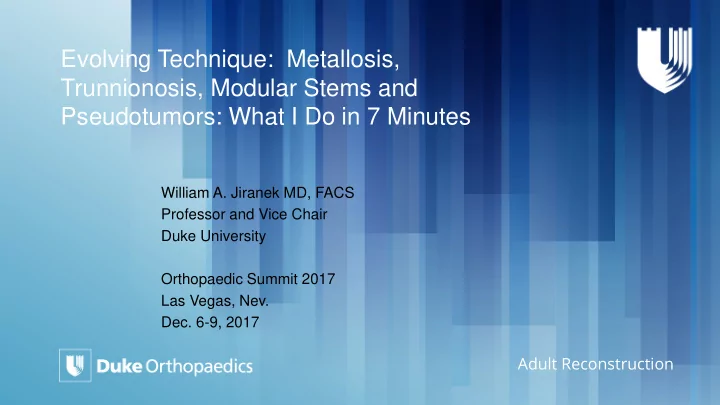

Evolving Technique: Metallosis, Trunnionosis, Modular Stems and Pseudotumors: What I Do in 7 Minutes William A. Jiranek MD, FACS Professor and Vice Chair Duke University Orthopaedic Summit 2017 Las Vegas, Nev. Dec. 6-9, 2017 Adult Reconstruction
Disclosure • Personal • Institution – Royalties – Research • Depuy and clinical – Consultant support: • Depuy • Depuy – BOD and • Stryker Committee • AAHK S, Hip Society
Adverse Local Tissue Response (ALTR) – Metal on Poly Revision for unexplained pain is uncommon (2%), and revision for metal problems (1%) and lysis (2%)
ALTR – Trunionnosis What do we know • Vague groin or trochanteric Is it occuring more frequently or Pain are we just recognizing more • Little relation to activity Big Heads More offset different alloys?
Diagnostic Workup (Jacobs, Rush) • Radiographs showed osteolysis of the proximal femur in seven hips (26%), generally seen in the area of the calcar or at the base of the greater trochanter • ESR and CRP elevated in 14/27 pts – ESR: 32 mm/hr (3.0 – 113) – CRP: 3.8 mg/dL (<0.5 – 19.9) • Aspirations performed in 21 of 27 pts Mean WBC count 6,939 WBC/ μL (range, 2 to 55,500) – • Mean 62% neutrophils (range, 12% to 99%) – WBC elevated in 6 cases • All preop/introperative cultures negative • All frozen sections negative for acute inflammation Plummer, D.R. J. Arthrop 31:264–268, 2016.
Metal Levels • Elevated Co levels in all 27 cases • Elevated Cr levels in 22 of 27 cases • Serum Co levels were differentially (p = 0.014, Wilcoxon signed-rank test) elevated over serum Cr levels Referenc Ion Mean Range e 1 (0.16 ± 1 Jacobs, ORS 2002 Co 11.2 ppb 1.1 – 49.8 0.10) (0.24 ± Cr 2.2 ppb 0.16 – 9.8 0.35)
Serum Cobalt • Serum cobalt is the best test for diagnosis of suspected ALTR following MoP THA – Optimal cut-off value of 1.0 ng/mL – Much lower than threshold for MOM bearings! • Serum Chromium also of value • Cobalt typically higher than Chromium Patients with a serum Cobalt > 1 ng/mL should undergo further evaluation for an ALTR secondary to corrosion YA Fillingham et al. J Arthroplasty 32 (9S), S272-S277. 2017 Apr 20.
75 yo male 1 yr s/p uncomplicated right THA, now with troch pain dxed as troch bursitus
Surgery for ALTR – trunionnosis • Identify the angle and the type of taper, ensure that you can obtain a sleeve • Thorough Debridement • Mechanically clear taper • Use ceramic head on a titanium sleeve • Recovery is slower and instability is common – 7% in Rush series
Solutions for Trunionnosis
Options with abductor damage
What about Modular femoral components? • If revising for trunionnosis – consider revising stem • May need ETO for removal of modular stem
Adverse Local Tissue Response (ALTR) – Metal on Metal • While placement of metal on metal devices is rare today, there are lots out there
Background Methods Results Significance Comparing ASR and Pinnacle Cohorts Key Findings - ASR – earlier timing to MRI, higher Cobalt (and Ratio) - No other significant differences - Pseudotumor Findings: - Similar prevalence, size, and category
Background Methods Results Significance Factors Associated With Pseudotumor Presence Key Findings - Patients with pseudotumor more likely to have: - Higher cobalt levels (and ratio) - High offset femoral component - Larger acetabular component
Background Methods Results Significance Pseudotumor Not Correlated With Symptoms * Key Findings - Symptomatic vs Asymptomatic: - Similar metal ion levels - Similar pseudotumor prevalence, size, and category - Pseudotumor present in 47% of asymptomatic patients *Symptomatic patients defined as having pain and/or weakness/limp
Background Methods Results Significance Conclusions: Effects of Pseudotumors In Patients - Overall high prevalence of pseudotumor in patients with MoM THA and MRI (52%) - Nearly 40% of pseudotumors either thick-walled cystic lesions or solid lesions - Factors significantly correlated with pseudotumor presence: - Elevated Cobalt ion levels and CoCr ratio - High offset stem - Increasing cup size - Patient symptoms may not be reliable indicator of pseudotumor presence or severity - 38% of pseudotumors were in asymptomatic patients, no correlation with severity - In asymptomatic cohort, pseudotumor prevalence was 47% - Revised patients have higher ion levels and more frequent and severe pseudotumors
Background Methods Results Significance High Rates of Post-Revision Complications Cohort ASR Pinnacle P-value (n = 106) (n = 50) (n = 56) Timing 0.0077 Early (<5 years) 45 (42%) 28 (56%) 17 (30%) Late (>5 years) 61 (58%) 22 (44%) 39 (70%) Patients w/ Complications 25 (24%) 11 (22%) 14 (25%) 0.7165 Revised for ARMD 15 (60%) 9 (82%) 6 (43%) 0.0484 Total Complications 31 14 16 Early (<5 years) 19 8 11* *0.0001 Late (>5 years) 11 6 5* ASR implants were revised significantly earlier Nearly 1 in 4 patients experienced a complication Revised Pinnacle implants were significantly likely to result in complication if revised within 5 years (All Pinnacle dislocations (n = 6) occurred within the early cohort)
Background Methods Results Significance MRI Imaging and Ion Levels – Complications Revisions Complication No Complication P-value (n = 106) (n = 25) (n = 81) Pseudotumor Presence 49 (46%) 6 (of 12 MRIs) 43 (of 62 MRIs) 0.1944 Greatest Length (cor or sag) 7.5 (6.5) 11.6 (8.2) 7.0 (6.4) 0.3303 Volume 228.7 (49.8) 872.4 (164.8) 153.8 (45.9) 0.1039 Category 20:15:14 1:2:3 19:13:11 0.1526 Cobalt 32.6 (12.6) 50.1 (24.5) 29.2 (12) 0.0435 Chromium 18.4 (5.3) 21.6 (16) 17.8 (3.8) 0.0889 Ratio 3.9 (2.5) 5.1 (2.9) 3.6 (2.4) 0.6205 Continuous variables recorded as Average (Median) No significant correlation between experiencing post-revision complication and pseudotumor presence, size, chromium level, or Co/Chr ratio Positive correlation between post-revision complication and cobalt levels
Conclusion • Trunion corrosion and MOM metallosis act differently • Metal threshold in MOP - 1 ppb Cobalt • MOP Cobalt > chromion • MOM Cobalt / Chromion
Moving forward. Climbing higher. Moving forward. Climbing higher.
Recommend
More recommend